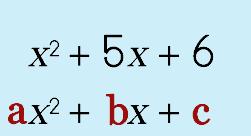 |
||
Any time you come across a quadratic equation there are several different ways or methods you can actually solve them. One way is to use what's called the 'quadratic formula.' This is probably something your parents will remember from Algebra class (and will be rolling their eyes as they remember it!). The formula has this oddball look to it… |
||
 |
||
 |
||||
Now, you may be thinking, "What in the heck? How do I use THIS thing?" It is actually quite simple! Just think about your quadratic EQUATION for a moment. It looks something like this, right? Well, then if you would think BACK to when you were first learning about the quadratic equation, you learned that the first term's coefficient is represented by the letter a, the second term is represented by the letter b, and the third by the letter c. |
||||
Why is all this so important, you may be wondering, right? The reason this is all so important is because you can find the solution to ANY quadratic equation by using the quadratic formula! WOW…amazing, right? So, it stands to reason that you should memorize this oddball formula. As long as you can remember it and you definitely should have no problem with remembering the 'standard' form of a quadratic equation (hint-hint: the form you see above) then you simply just substitute the values for a, b, and c into the quadratic formula. Now, keep in mind that I am going to show you what I think is a good way to go about using the formula…someone else may tell you to go about it a different way… |
||
Step 1: Start with your quadratic equation in standard form
|
||||||||
 |
||||||||
Step 2: Use the discriminant to determine the number of solutions you will get
|
||||||||||
 |
||||||||||
A-ha! Perfect square! This means we will have two solutions. |
||||||||||
 |
||||||
 |
||||||
Step 3: Substitute each the last two coefficients in the formula.
|
||||||
 |
 |
|||||||||
Step 4: Simplify
|
||||||||||
Step 5: Solution
|
||||||||
Ahhhh…you have come up with that little issue that can be EASILY explained when you understand the discriminant. (For those of you who can find the base word in 'discriminant' you will probably be able to figure out what this is going to get at…) When you learned about radicals you learned that the number/term under the radical sign is called the radicand. When you are working with the quadratic formula, the expression found under the radical sign is called the discriminant. This is a rather important expression, as you will soon learn. Let's take a look at WHY you want to learn about the discrimant. |
||
|
|||||||||||||||||||||||||||||||||||||||||||||||||||||||||||||||||||||||||||||||||||||||||||||||||||||||||||||||||||||||||||||||||||||||||||||||||||||||||||||||||||||||||||||||||||||||||||||||||||||||||||||||||||||||||||||||||||||||||||||||||||||||||||||||||||||||||||||||||||||||||||||||||||||||||||||||||||||||||||||||||||||||||||||||||||||||||||||||||||||||||||||||||||||||||||||||||||||||||||||||||||||||||||||||||||||||||||||||||||||||||||||||||||||||||||||||||||||||||||||||||||||||||||||||||||||||||||||||||||||||||||||||||||||||||||||||||||||||||||||||||||||||||||||||||||||||||||||||||||||||||||||||||||||||||||||||||||||||||||||||
©2011–2017 Sherry Skipper Spurgeon. All Rights Reserved. |
||






